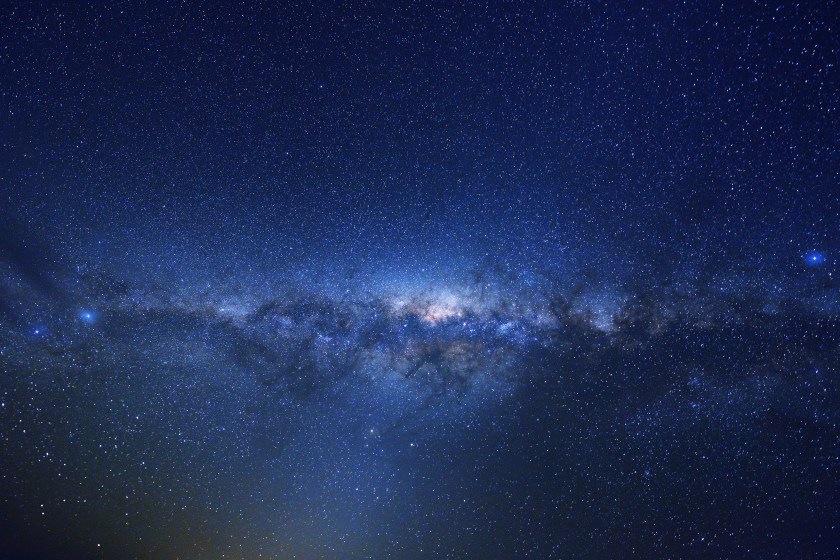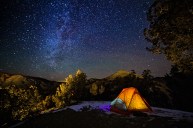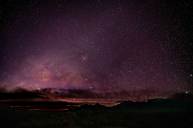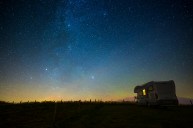The BlueWalker 3 satellite, built by AST SpaceMobile, launched nearly a month ago, heralding the first steps in global 5G cellular connectivity—beaming straight from space to your everyday smartphone. BlueWalker 3 and its successors will bring global 5G to even the hard-to-reach areas, essentially turning every cellphone into a satellite phone. This is great news for people who recreate in the backcountry, as we won't have to rely on a separate satellite communication device to stay safe and connected on our trips. It'll also give remote workers a lot more freedom: they'll be able to access 5G networks on their devices while on even the most off-the-beaten-path road trips.
But BlueWalker 3—and all the AST SpaceMobile satellites to follow—are bad news for astronomers and stargazers.
Looking a bit like a Tetris board, the massive satellite has an antenna that's 692 square feet. This is about 40 times bigger than the original Starlink satellite, one of AST SpaceMobile's competitors. The entire surface of BlueWalker 3 antenna reflects sunlight—a lot of it. In fact, a new study found that the BlueWalker 3 puts off a brightness level on par with Procyon and Achernar, two of the brightest stars in the sky.
History is unfolding! We've deployed #BlueWalker3's 693-square-foot array, which is now the largest-ever commercial communications array in low Earth orbit.
Read more about this important milestone here: https://t.co/4kupfxn3vO pic.twitter.com/KnE9CeWOCT
— AST SpaceMobile (@AST_SpaceMobile) November 14, 2022
The study showed the satellite is about 900 times brighter than objects that shine at magnitude 7, the satellite brightness limit that the International Astronomical Union recommends to head off the most severe effects on astronomy. A magnitude 7 object is just outside the visual limits of the human eye—while BlueWalker 3 is impossible to miss.
"After BlueWalker 3 unfolded its 64m2 array, it is visible in both dark sky and urban skies, though in urban settings, this will be limited to when BlueWalker 3 passes overhead," Dr Jeremy Tregloan-Reed, a co-author of the study at the Universidad de Atacama in Chile, told The Guardian.
A Problem for the Astronomy Community

Getty Images Photographer, zorazhuang
The study notes that "large constellations of bright artificial satellites in low Earth orbit (LEO) pose significant challenges to ground-based astronomy."
The incredible brightness of the new satellite doesn't only lighten the surrounding night sky. It also leaves a streak across telescope detectors that's nearly impossible to remove and alters the data and pixels around the streak. In short, it's a glaring problem.
The researchers of the new study also note another concern: The radio frequencies used by BlueWalker 3 are close to those used for radio astronomy, raising the possibility that BlueWalker 3 and similar satellites could cause interference with astronomer's radios. Altogether, it seems the satellite will make it harder for scientists to study the universe from earth.
Only the Beginning

StockbyM, Getty Images Photographer
BlueWalker 3 is just the first of many planned satellites by AST SpaceMobile, and just part of a growing trend of companies launching bigger and brighter satellites. Satellite constellations already exist from SpaceX and OneWeb, and Amazon has plans to launch 3,200 satellites for its Project Kuiper.
According to Astronomy, astronomers are looking to forge a relationship with satellite firms to manage their effects. A database called SatHub is also in the works to track satellites and their predicted motions, allowing astronomers to plan their observations around satellite orbits.
Satellites like BlueWalker 3 are bad news for astronomers. But does their potential good for cell service on earth outweigh their problems? A spokesperson at AST SpaceMobile told The Guardian that by building its space-based cellular broadband network, it aims to alleviate poverty, spur economic development, and save lives. Its constellation is expected to involve around 90 satellites, the spokesperson said, far fewer than some others.
The spokesperson also stressed that the company is working to address the concerns of astronomers, including using anti-reflective materials and avoiding broadcasts within or adjacent to the U.S. National Radio Quiet Zone. The night sky will soon show whether these tactics preserve our view of the stars and universe beyond.
Read More: The Best Dark Sky Parks for Stargazing




